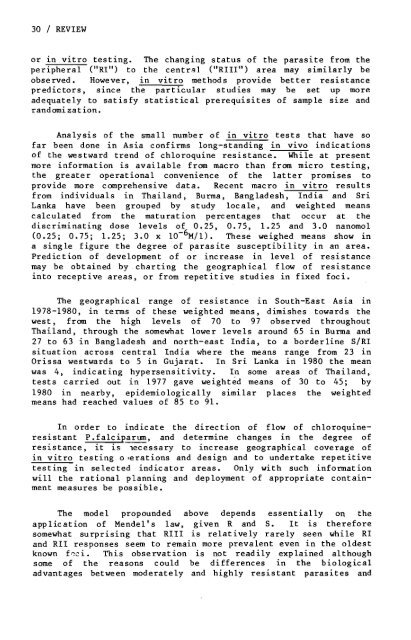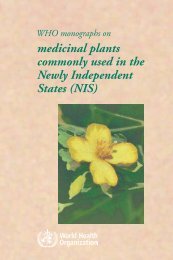Drug-Resistant Malaria - libdoc.who.int - World Health Organization
Drug-Resistant Malaria - libdoc.who.int - World Health Organization
Drug-Resistant Malaria - libdoc.who.int - World Health Organization
You also want an ePaper? Increase the reach of your titles
YUMPU automatically turns print PDFs into web optimized ePapers that Google loves.
30 I REVIEW<br />
or in vitro testing. The changing status of the parasite from the<br />
peripheral ("RI") to the central ("Rlll") area may similarly be<br />
observed. However, in vitro methods provide better resistance<br />
predictors, since the particular studies may be set up more<br />
adequately to satisfy statistical prerequisites of sample size and<br />
randomization.<br />
Analysis of the small number of in vitro tests that have so<br />
far been done in Asia confirms long-standing in vivo indications<br />
of the westward trend of chloroquine resistance. While at present<br />
more information is available from macro than from micro testing,<br />
the greater operational convenience of the latter promises to<br />
provide more comprehensive data. Recent macro in vitro results<br />
from individuals in Thailand, Burma, Bangladesh, India and Sri<br />
Lanka have been grouped by study locale, and weighted means<br />
calculated from the maturation percentages that occur at the<br />
discriminating dose levels of 0.25, 0.75, 1.25 and 3.0 nanomo1<br />
(0.25; 0.75; 1.25; 3.0 x 1O-6M/l). These weighed means show in<br />
a single figure the degree of parasite susceptibility in an area.<br />
Prediction of development of or increase in level of resistance<br />
may be obtained by. charting the geographical flow of resistance<br />
<strong>int</strong>o receptive areas, or from repetitive studies in fixed foci.<br />
The geographical range of resistance in South-East Asia in<br />
1978-1980, in terms of these weighted means, dimishes towards the<br />
west, from the high levels of 70 to 97 observed throughout<br />
Thailand, through the somewhat lower levels around 65 in Burma and<br />
27 to 63 in Bangladesh and north-east India, to a borderline SIRI<br />
situat ion across central India where the means range from 23 in<br />
Orissa westwards to 5 in Gujarat. In Sri Lanka in 1980 the mean<br />
was 4, indicating hypersensitivity. In some areas of Thailand,<br />
tests carried out in 1977 gave weighted means of 30 to 45; by<br />
1980 in nearby, epidemio1ogica11y similar places the weighted<br />
means had reached values of 85 to 91.<br />
In order to indicate the direction of flow of ch10roquineresistant<br />
P.falcipartnn, and determine changes in the degree of<br />
resistance, it is l.ecessary to increase geographical coverage of<br />
in vitro testing o.erations and design and to undertake repetitive<br />
testing in selected indicator areas. Only with such information<br />
will the rational planning and deployment of appropriate containment<br />
measures be possible.<br />
The model propounded above depends essentially on the<br />
application of Mendel's law, given Rand S. It is therefore<br />
somewhat surprising that RIll is relatively rarely seen while RI<br />
and RII responses seem to remain more prevalent even in the oldest<br />
known f·')ci. This observation is not readily explained although<br />
some of the reasons could be differences in the biological<br />
advantages between moderately and highly resistant parasites and
















